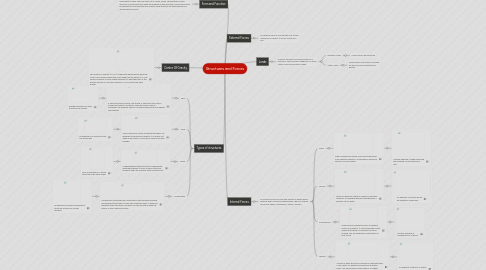
1. Types of structures
1.1. Shell
1.1.1. A shell structure is hollow, yet strong. A shell structure uses a minuscule amount of material. They are mainly used as containers for different objects. An egg is hollow but firm against some things.
1.1.1.1. Another example of a shell structure is a Helmet.
1.2. Solid
1.2.1. A solid structure is solid all the way through. It is designed to hold heavy objects. It is usually not made to be mobile. A pyramid is solid all the way through.
1.2.1.1. An example of a solid structure is a marble ball.
1.3. Frame
1.3.1. A regimentation with structural componenets fastened together to form a Frame structure. Different parts are made to make a motorcycle.
1.3.1.1. Also, an example of a frame structure is the Eiffel tower.
1.4. Combination
1.4.1. Combination structures are compositions that combine multiple and different structures to make one complex object. A shoe has different other structures. The heel is a shell structure while the interior is like a frame structure.
1.4.1.1. An extremely complex combination structure would be a Human Skeleton
2. Form and Function
2.1. Form and Function are the building blocks of a structure. Without them you don't know what to build. The form tells if it is a solid, frame, combination or shell structure. The function tells what the purpose of the structure. The function must be thought out first because you need to know that you are doing before you decide how to build it.
3. Centre Of Gravity
3.1. The Centre Of Gravity (C.O.G) is the point where gravity pulls the most. It also means where the most weight on the object is. A low centre of gravity is more stable because it is near the base. In the picture above you can see a person's C.O.G is near their belly button.
4. Internal Forces
4.1. An internal force is a force that affects an object when external when loads are being applied. The four internal forces are: shear, compression, torsion, tension.
4.1.1. Shear
4.1.1.1. Shear is when two parallel forces are interacting in an opposite direction. An example is pulling to strands of licorice apart.
4.1.1.1.1. Another example of shear would be like breaking a chocolate bar in half.
4.1.2. Torsion
4.1.2.1. Torsion is when you twist an object in opposite direction. An example would be wringing out a sponge out it's water.
4.1.2.1.1. An example of torsion would be twisting a coiled wire.
4.1.3. Compression
4.1.3.1. Compression is when the force is pushing down on an object. It could make the object smaller but thicker. An example could be running. You are pushing you feet down on floor to run.
4.1.3.1.1. Another example of compression is a spring .
4.1.4. Tension
4.1.4.1. Tension is when the force is pulling on opposite sides of an object. An example is pulling on an elastic band. You are pulling on both sides of an rubber band.
4.1.4.1.1. An example of tension in action would be a game of tug of war.
5. External Forces
5.1. An External Force is a force that acts on the outside of an object. It can be a push or a pull.
6. Loads
6.1. A load is the effect of forces acting on a structure. There are two categories of loads. Static Loads and Dynamic Loads.
6.1.1. Dynamic Loads
6.1.1.1. A live load on the structure
6.1.2. Static Loads
6.1.2.1. Dead load on a structure is caused by the only force affecting it is gravity.

